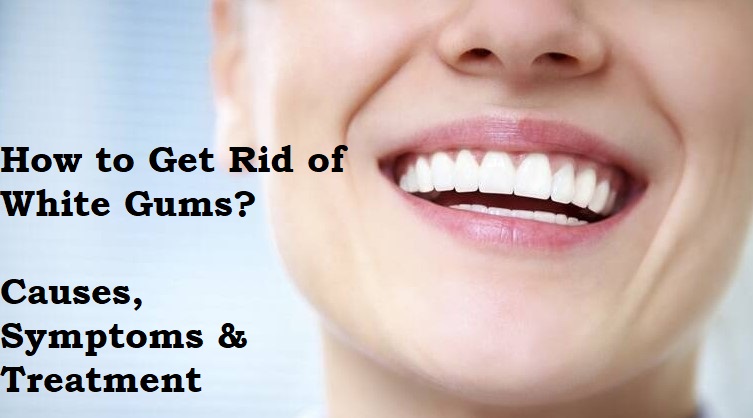Gums are the most overlooked part of our mouth. By and large, most people have no idea that solid gums should be pink. In any case, because of gum problems, contamination, and carelessness of oral hygiene, gums around teeth can become white.
White gums, from time to time, may also show abnormal growth. Therefore, an individual should visit a dental specialist as soon as he/she notices even a slight change in the shade of the gums.
Table of Contents
Symptoms of White Gums
Symptoms that might accompany white gums can vary based on the hidden reason for the variety of changes.
Rarely, an individual might not experience any different side effects. In different cases, white gums can be joined by:
- torment
- enlarging
- dying
- injuries and sores
- free teeth
- redness
- exhaustion, dazedness, or shortcoming
- migraines
- cold hands and feet
Monitoring any additional side effects can assist a specialist or dental specialist in diagnosing the root cause of white gums.

Reasons for White Gums
There can be many reasons for gums becoming white. Following next are some of them:
Frailty
The lack of red blood cells causes weakness. These cells are required for transporting oxygen around the body. The most common reasons for the weakness are lack of iron and nutrient B13, Crohn’s illness, and celiac infection. Individuals who experience age-related frailty may also have white patches on their gums.
Infection
Infections can develop in the mouth as well as on the gums. These bruises cause pain and discomfort, especially while eating and talking. The sore shape of the gums can turn the gums white.
Gum Disease
It is a type of gum condition, but a mild one. This is one of the gum sicknesses that affect almost half of Americans. The obliviousness to dental cleanliness is the primary driver of gum disease. The gums become red and enlarged, and teeth begin to appear free. With time the gums might become white and begin to recede.
Oral Thrush
Yeast contamination is the primary driver of the raised white spot. Affected areas of the cheeks, tongue, and gums are impacted by oral thrush.
Tooth Extraction
The gum region surrounding tooth extraction can turn white. Despite this, the gums will return to their original tone within a couple of days.
White gums around teeth can be a symptom of more serious problems if left untreated. In this way, any change to the gums should be discussed with the dental professional.
Treatment for White Gums
White gums are treated for the reason they are white.
Sickliness
Dietary changes, nutrient enhancements, and dealing with any constant medical issue can combat weakness.
Infection
Minor infections usually resolve in no less than about fourteen days, usually requiring no treatment. Significant injuries can require as long as about a month and a half to recover and should be assessed by a specialist or dental specialist.
Medicines for a blister that does not heal include:
- drug for help with discomfort
- salt-water washes
- oral treatments and gels
- oral steroids
- in serious cases, burning or fixing
Gum Disease
Gum disease is not difficult to treat with improved dental hygiene practices. Forestalling and treating gum disease include brushing and flossing every day and scheduling regular dental check-ups.
Serious cases might require scaling or laser cleaning.
Leukoplakia
Patches of leukoplakia can be frozen off or eliminated with a surgical blade or laser. Individuals with the condition ought to try not to smoke or chew tobacco.
A specialist might prescribe antiviral medications on the off chance that an individual additionally has a debilitated immune framework.
Oral Lichen Planus
There is no cure for oral lichen planus, but one can manage side effects with:
- corticosteroids to cut down aggravation
- desensitizing gels to lighten torment
- drugs to smother the invulnerable framework
Oral Thrush
Oral thrush is usually treated with antifungal prescriptions. A specialist might suggest taking a tablet, capsule, or mouth wash.
Oral Malignant Growth
More than 50 percent of oral malignant growth cases remain undetected until the disease has spread to different regions, like the lymph hubs. Therefore, seeing a specialist at the earliest opportunity is fundamental.
Treatment options include chemotherapy and surgical removal of the impacted regions.
Prevention
The most effective strategy for counteraction is to maintain effective oral hygiene.
Ideas include:
- brushing two times every day, flossing one time per day, and utilizing a mouth wash
- Oral cleanliness products that do not contain sodium lauryl sulfate, as this can add to ulcer improvement
- Avoid using an extremely firm toothbrush as it might bother the gums and delicate tissues in the mouth
- visiting a dental specialist for regular checkups and cleanings
- By using a tongue scrubber to eliminate plaque, food particles, and microscopic organisms from the tongue
- Practicing methods of decreasing pressure, such as exercise, contemplation, and moderate muscle unwinding
- eating a healthy diet and limiting the intake of sugar, salt, and liquor
- staying away from the consumption of tobacco and any items containing it
- tending to the hidden medical issues immediately
Although it is intriguing, white spots in the mouth can occur as a result of hypersensitivity to dental items. Individuals should immediately stop using any newly acquired items that cause an adverse reaction.
FAQs
Minor blisters usually heal in no less than about fourteen days, for the most part with minimal or no treatment. Significant bruises can require as long as about a month and a half to heal and should be assessed by a specialist or dental specialist.
The gum region surrounding tooth extraction can appear white. In any case, the gums will return to their normal color within a couple of days. White gums around teeth can be a symptom of significant dental problems if left untreated. In this way, any changes to the color of the gums should be communicated to the dental specialist.
White gums are often a sign that something is awry with an individual’s oral hygiene. There are different conditions that can cause white gums, from infection to long-lasting problems. In some cases, white gums can indicate oral disease, so seeing a specialist for a legitimate diagnosis is fundamental.
